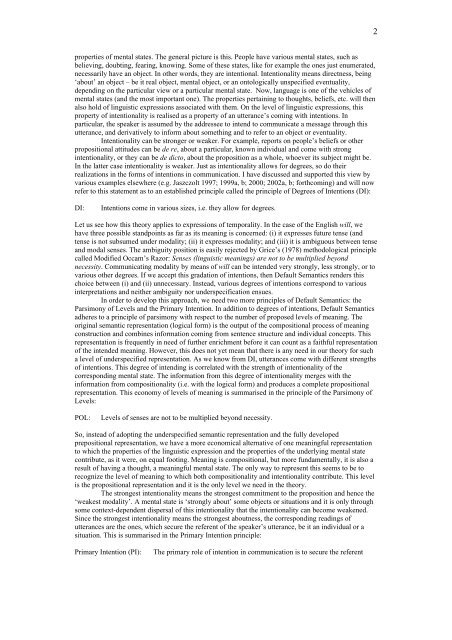SemPrag03.Progr.pdf - Institut für Linguistik/Germanistik - Universität ...
SemPrag03.Progr.pdf - Institut für Linguistik/Germanistik - Universität ...
SemPrag03.Progr.pdf - Institut für Linguistik/Germanistik - Universität ...
Create successful ePaper yourself
Turn your PDF publications into a flip-book with our unique Google optimized e-Paper software.
2<br />
properties of mental states. The general picture is this. People have various mental states, such as<br />
believing, doubting, fearing, knowing. Some of these states, like for example the ones just enumerated,<br />
necessarily have an object. In other words, they are intentional. Intentionality means directness, being<br />
‘about’ an object – be it real object, mental object, or an ontologically unspecified eventuality,<br />
depending on the particular view or a particular mental state. Now, language is one of the vehicles of<br />
mental states (and the most important one). The properties pertaining to thoughts, beliefs, etc. will then<br />
also hold of linguistic expressions associated with them. On the level of linguistic expressions, this<br />
property of intentionality is realised as a property of an utterance’s coming with intentions. In<br />
particular, the speaker is assumed by the addressee to intend to communicate a message through this<br />
utterance, and derivatively to inform about something and to refer to an object or eventuality.<br />
Intentionality can be stronger or weaker. For example, reports on people’s beliefs or other<br />
propositional attitudes can be de re, about a particular, known individual and come with strong<br />
intentionality, or they can be de dicto, about the proposition as a whole, whoever its subject might be.<br />
In the latter case intentionality is weaker. Just as intentionality allows for degrees, so do their<br />
realizations in the forms of intentions in communication. I have discussed and supported this view by<br />
various examples elsewhere (e.g. Jaszczolt 1997; 1999a, b; 2000; 2002a, b; forthcoming) and will now<br />
refer to this statement as to an established principle called the principle of Degrees of Intentions (DI):<br />
DI:<br />
Intentions come in various sizes, i.e. they allow for degrees.<br />
Let us see how this theory applies to expressions of temporality. In the case of the English will, we<br />
have three possible standpoints as far as its meaning is concerned: (i) it expresses future tense (and<br />
tense is not subsumed under modality; (ii) it expresses modality; and (iii) it is ambiguous between tense<br />
and modal senses. The ambiguity position is easily rejected by Grice’s (1978) methodological principle<br />
called Modified Occam’s Razor: Senses (linguistic meanings) are not to be multiplied beyond<br />
necessity. Communicating modality by means of will can be intended very strongly, less strongly, or to<br />
various other degrees. If we accept this gradation of intentions, then Default Semantics renders this<br />
choice between (i) and (ii) unnecessary. Instead, various degrees of intentions correspond to various<br />
interpretations and neither ambiguity nor underspecification ensues.<br />
In order to develop this approach, we need two more principles of Default Semantics: the<br />
Parsimony of Levels and the Primary Intention. In addition to degrees of intentions, Default Semantics<br />
adheres to a principle of parsimony with respect to the number of proposed levels of meaning. The<br />
original semantic representation (logical form) is the output of the compositional process of meaning<br />
construction and combines information coming from sentence structure and individual concepts. This<br />
representation is frequently in need of further enrichment before it can count as a faithful representation<br />
of the intended meaning. However, this does not yet mean that there is any need in our theory for such<br />
a level of underspecified representation. As we know from DI, utterances come with different strengths<br />
of intentions. This degree of intending is correlated with the strength of intentionality of the<br />
corresponding mental state. The information from this degree of intentionality merges with the<br />
information from compositionality (i.e. with the logical form) and produces a complete propositional<br />
representation. This economy of levels of meaning is summarised in the principle of the Parsimony of<br />
Levels:<br />
POL:<br />
Levels of senses are not to be multiplied beyond necessity.<br />
So, instead of adopting the underspecified semantic representation and the fully developed<br />
prepositional representation, we have a more economical alternative of one meaningful representation<br />
to which the properties of the linguistic expression and the properties of the underlying mental state<br />
contribute, as it were, on equal footing. Meaning is compositional, but more fundamentally, it is also a<br />
result of having a thought, a meaningful mental state. The only way to represent this seems to be to<br />
recognize the level of meaning to which both compositionality and intentionality contribute. This level<br />
is the propositional representation and it is the only level we need in the theory.<br />
The strongest intentionality means the strongest commitment to the proposition and hence the<br />
‘weakest modality’. A mental state is ‘strongly about’ some objects or situations and it is only through<br />
some context-dependent dispersal of this intentionality that the intentionality can become weakened.<br />
Since the strongest intentionality means the strongest aboutness, the corresponding readings of<br />
utterances are the ones, which secure the referent of the speaker’s utterance, be it an individual or a<br />
situation. This is summarised in the Primary Intention principle:<br />
Primary Intention (PI):<br />
The primary role of intention in communication is to secure the referent

















